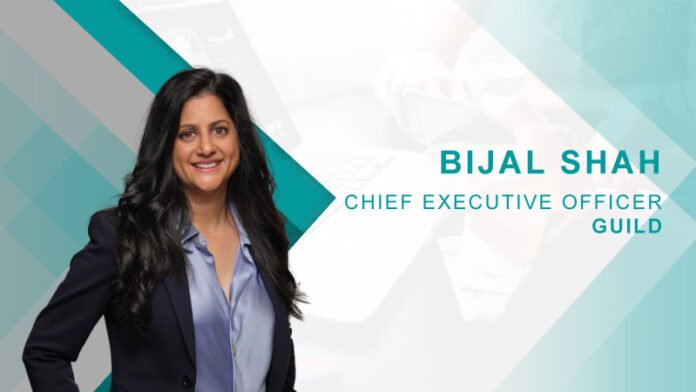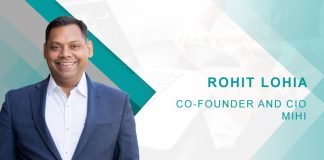Welcome to the HRTech Cube Bijal. We’re excited to have you with us to discuss Guild’s latest research and the evolving role of L&D in driving business strategy.
To start, could you please share a bit about your professional journey and what led you to your current role as CEO of Guild?
My background is in data science and my career has spanned many different hats. Before Guild, I was in leadership roles at Ibotta and worked in corporate strategy at Visa. I then landed at Guild seven years ago when the company was still in early formation and I was hired as the first Chief Product and Analytics Officer. During my time at Guild, I have led a variety of teams, including product, engineering, and analytics. My most recent role, before stepping into the CEO position, was Chief Experience Officer, overseeing how we brought together our product, service operations, and technology to support learners.
Then, in 2023 I got a call that Rachel Romer, Guild’s founder and former CEO, had a stroke. I stepped in as CEO so that she could focus on recovery. I am glad that the board trusted me to take on this role, and I am immensely grateful for our leadership team who stepped up to support me during the transition. I’m bullish on Guild’s growth and the impact we can drive, and it has been inspiring to lead a company of motivated and focused teams and to experience the momentum we are building from this seat.
Guild’s new report, From Cost to Catalyst, reveals a strong connection between L&D investments and business outcomes. How can HR leaders hone in on this connection and make the most of it?
We have seen clearly from our work with leading employers that those who strategically link L&D to their company’s business objectives are able to drive extraordinary outcomes. The data underscored this, showing that HR leaders who tie learning to their organization’s biggest business priorities are 122% more likely to meet or exceed their highest-priority metrics.
To get there, leaders need to measure what matters to the business, build partnerships throughout the organization, and then explain value in a way that resonates with those partners. There is sometimes a disconnect with positioning alone, when L&D leaders use terms like “competencies” and “micro-learning” when other leaders in the business care about growth, productivity, and the bottom line. Uniting these efforts under business impact and using language business unit and c-level executives are familiar with will resonate deeper and ultimately have a greater impact.
One of the most compelling findings is that HR leaders who link L&D to business priorities are significantly more likely to hit their top metrics. Can you share an example of what that alignment looks like in practice?
Alignment for companies that do this well needs to be very intentional, but it is absolutely doable. I would suggest starting by including L&D leaders in business planning from the beginning, creating “allies” in other departments, and using business metrics to drive L&D implementation.
One L&D leader at a global financial services firm shared with us that his team was seen as a compliance-driven support function. To reposition his team as a strategic partner, he set out to integrate his people deeply in the business. The team attended cross-functional meetings and aligned closely with HR business partners. They identified and voiced the talent needs they observed, asked thoughtful questions about the function’s goals and launched a structured competency assessment targeting one business unit at a time. They rated and prioritized competencies, assessing everything from the lens of what was critical to the business. With this information, rooted in strategic priorities, they co-created programs with the business units—resulting in increased participation, satisfaction, and behavior changes.
The report outlines the “4 I’s” framework—Integration, Influence, Internal Mobility, and Impact. Which of these principles do you think HR teams struggle with the most, and how can they overcome that challenge?
In conversation with HR leaders, I have found that integration can be the hardest piece of the puzzle. Oftentimes, those outside of HR see L&D as a check-the-box activity. HR leaders have the opportunity to rewrite this narrative and shift preconceived ideas about the impact of L&D. They can do this by integrating themselves into different functions across the business to understand their strengths, weaknesses, big goals and how talent strategy supports these areas. With this larger picture in mind, HR leaders can create a tailored L&D plan that aligns the skills employees are developing with s each team’s objectives.
Integration is key to making L&D a strategic asset. How can companies embed learning into planning cycles without adding unnecessary complexity?
One thing we noticed while conducting our research was that the most successful organizations made some simple, but powerful changes, including abandoning annual planning cycles for quarterly prioritization meetings tailored to real-time business needs, embedding L&D voices in existing business meetings, and identifying must-have versus nice-to-have capabilities. Each of these changes helps companies evolve employee development from a cost barrier to an ongoing, flexible strategic asset.
Influence and trust with senior leadership came up as a distinguishing trait for high-performing HR leaders. In your view, what builds that credibility?
Metrics and examples! Being able to quantify and showcase how the work that you are doing is directly influencing the bottom line is what builds trust and influence. One of the HR leaders we interviewed told us she hired a data engineer to develop dashboards and visuals that made their reporting easy to digest for stakeholders. The engineer helped bring disparate sources into one accessible ecosystem, enabling her team to report on performance, spot trends, and tie learning directly to operational outcomes. When ROI is tangible, credibility is earned.
The data suggests internal mobility is a top marker of success. How should organizations be rethinking career pathways to support advancement from within?
Internal mobility has become critical, especially in industries like healthcare and manufacturing, where more people are leaving the workforce than entering. Rethinking career pathways has to happen at multiple levels, starting by creating those clear routes for people to move around internally beyond the traditional hierarchy. It is important to think about moving across functions – from frontline to specialized roles, from non-clinical to clinical positions. In the last five years at Guild, we have helped healthcare organizations move more than 11,000 employees into high-demand healthcare roles, which has a massive impact on hiring costs and the ability to deliver care.
Beyond developing the pathways themselves, companies need to build a culture that supports internal mobility. This can look different depending on the company. I have seen some embed mobility into performance goals for managers, making them accountable not just for team performance but for talent development. Others intentionally design a “build vs. buy” framework – looking at the talent internally before moving externally to find candidates, and investing in durable skills development by giving people the right learning opportunities to transition between roles successfully.
On a personal level, how do you approach strategy-setting and prioritization as a CEO when it comes to investing in people and development?
As CEO, I am constantly thinking about two things: growth and resilience. I am focused on ensuring that we deliver on our mission as efficiently and effectively as possible. My approach to investing in people and development starts by looking at the business’s 1, 3, 5 year goals, assessing where the market is headed, consulting deeply with our own People team and working backwards. We find where the pain points are, make a plan of action, and develop pathways to meet those goals. We are not just thinking about what employees and our business need today, but what they’ll need as the workforce transforms, especially with the growth in AI.
After we develop these pathways and opportunities, we make sure to track the progress: Are people developing the skills needed to fill the roles that matter most? Are we seeing improved retention and performance especially for critical roles and talent? These are the things that drive performance, and at the end of the day my goal is to build a company that drives the greatest impact for our stakeholders, while supporting growth opportunities for our own employees where possible.
What advice would you offer HR and L&D leaders who are looking to shift the perception of learning from a cost center to a true growth engine?
One thing that HR and L&D leaders often forget is the importance of collaboration. When looking to shift the perception of L&D it takes true collaboration not just within the HR team, but throughout the organization. Every arm of the company needs to come together, share challenges, strengths, and ideas, in order for learning and talent initiatives to truly drive the business into the future. The shift from cost center to growth engine happens when you start measuring and communicating like a business unit, not a support function.
Finally, what’s one thought you’d like to leave our readers with as they look to evolve their own approach to talent and learning in 2025 and beyond?
One thing I would love to highlight is the importance of L&D not only to the business, but to each employee. With technology rapidly changing and AI transforming how we work, learn, and grow, there has never been a more critical moment for HR to ensure the resiliency of our workforce and the individuals that comprise it.
If you take one thing away from this, it is not to wait for permission to be strategic and create opportunity for your employees—in a way that meaningfully impacts the business. Start measuring what matters, partner with other functions and prove your value through results.

Bijal Shah CEO of Guild
Bijal Shah is the CEO of Guild, a talent development company partnering with leading employers to help them build the talent needed for today and the resilient workforce of tomorrow. Guild works with organizations like Chipotle, JP Morgan Chase, Target, and Providence Health to provide seamless pathways for talent mobility that enhance the employee experience and activate internal talent to achieve business goals. Bijal has been named a CNBC Changemaker and Guild has been recognized as one of TIME’s Most Influential Companies, CNBC’s Disruptor 50, LinkedIn’s Top Startups, and received Fast Company’s World Changing Ideas award.
Prior to Guild, Shah held leadership roles across engineering and analytics at Ibotta and corporate strategy at Visa. She served on the Board of Directors of Girls, Inc., and was named one of Denver Business Journal’s 40 Under 40. Shah graduated from the University of Pennsylvania and the MIT-Sloan School of Management. She lives in Denver with her husband and children.












